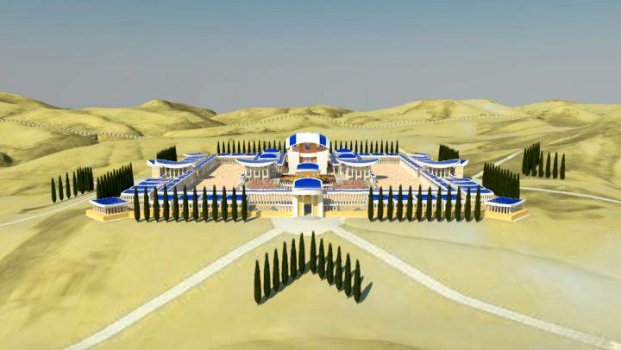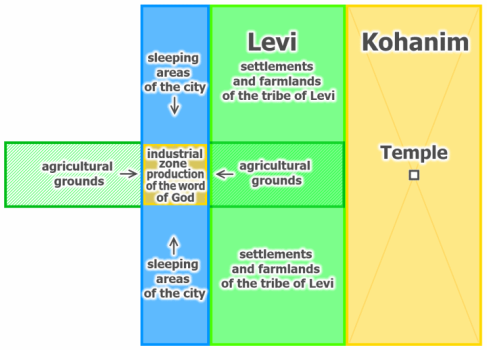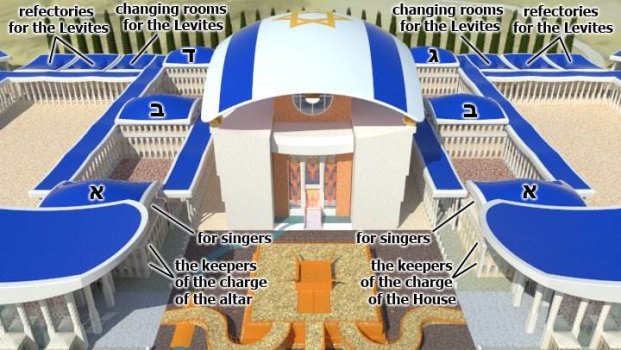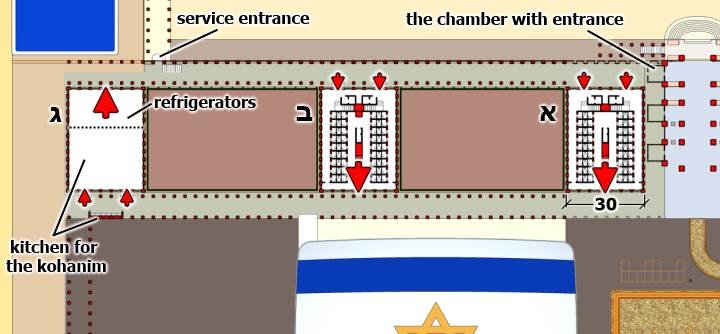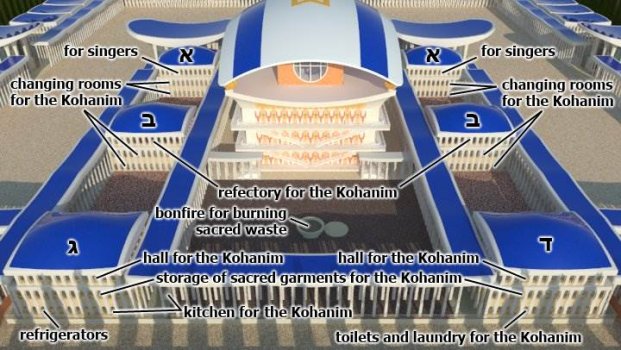Now let us imagine the entire route of the sacrifice. The animals will be sold in the marketplace, located along the perimeter along the outer wall outside the Lord's estate. Ezekiel told us the width of this marketplace: 50 cubits, that is, 24 meters.
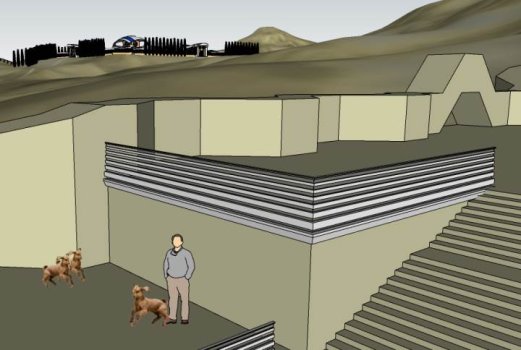
There may be pens for livestock there. On normal days, sacrificial animals are bought directly there, but on Saturdays only animals that have already been sold in advance may be waiting for their new owners there. The visitor takes his animal and goes with it to the Temple, by the usual route, entering the temple complex either through the northern or southern gates.
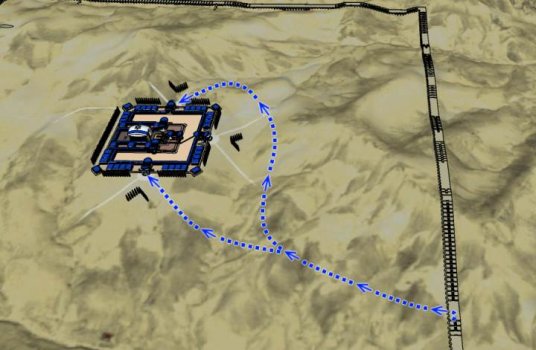
Next, the visitor approaches the gates to the inner court and stands in the general queue there together with his animal. If the sacrifice is for a sin offering (chatat), or a guilt offering (asham), or a burnt offering (ola), then such sacrifices may be made only at the northern gate of the inner court, and only on weekdays. Peace offerings (shelamim) are brought on any day, both at the northern and southern gates of the inner court.
When it is his turn, the visitor, together with the animal, crosses the gate line of the inner court, and immediately, at the gate, lays his hands on the sacrificial animal, pronouncing the appropriate formula explaining what kind of sacrifice the sacrifice he is bringing belongs to. The animal is taken by one of the Levites and led to the square in front of the Temple. There, the Levites, assisting the Kohanim, slaughter the animal and pour the required amount of blood into a vessel, which the kohan takes to walk around the altar with it, sprinkling the lower half of the bronze walls of the altar on all four sides.

The Levites pour the remaining unused blood into special holes in the ground, connected by pipes to a special sewage system for animal blood.

After the blood has drained from the carcass, the Levites take the carcass to the gate hall, where hooks are made in the booths and along the walls, on which the carcasses of animals are hung for skinning and butchering.After the carcass has acquired a marketable appearance, if it is a peace offering, the Levite takes this carcass out to the area in front of the gate, where four wooden tables are located.

The carcass lying on such a table, in the presence of the owner who brought this sacrifice, the Levite cuts up in such a way as to separate the portion for the koanim - the breast part and the right front leg. The owner who brought this sacrifice must take the breast portion in his hands and shake it, throwing it up so that the kohen who is near the altar can see it - the Israelite who brought the sacrifice again crosses the line of the gate of the inner courtyard, carrying these parts of the carcass, and there he places them on a table near the entrance to the gate, for subsequent removal of the meat to the refrigerators located in the building for the Kohanim near the western wall.
These portions are given to the Kohanim, but they are not sacred, because they are portions of a peace offering. Therefore, these portions are then carried out by the Levites through a side room in the hall of the gate of the inner court, which has a door for passage to the outer row of galleries near the buildings of the Kohanim, and these portions are taken to the last building, near the western wall, where there are refrigerators for storing this meat. It belongs to the Kohanim, but it is not sacred, so they can take it to their homes, outside the Temple complex.
After separating the portion of the sacrificial meat that is required by law for the ko'anim, the visitor takes his portion of the carcass and carries it to one of the kitchens, where a team of Levitical cooks will prepare kebabs from the meat.
This picture shows the route of the meat of the various types of sacrifices:
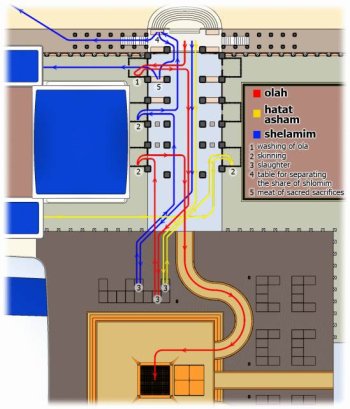
In the room near the gate they wash the feet of the sacrificed animal for the burnt offering.
In this room there is a door at the back, not for carrying the burnt offering there, but for taking out parts of the meat of the peace offerings for the Kohanim.
The meat of the burnt offering is burned on the altar. The meat of the sin offerings, chatat, and the meat of the guilt offerings, asham, may be eaten only by the koanim, and this meat is brought to the building at the western wall on the north side of the inner court, where the kitchen of the Kohanim is located.
This meat is carried along the inner row of galleries, from the side of the Temple. The priestly share of the meat of the peace offerings has no sacred status; a kohen may not only bring this meat home (within the sacred lot), but he may also sell this meat to another Israelite, anyone who has the right to eat the meat of the peace offerings. This meat is carried along the outer row of galleries, from the side of the outer court.

There may be pens for livestock there. On normal days, sacrificial animals are bought directly there, but on Saturdays only animals that have already been sold in advance may be waiting for their new owners there. The visitor takes his animal and goes with it to the Temple, by the usual route, entering the temple complex either through the northern or southern gates.

Next, the visitor approaches the gates to the inner court and stands in the general queue there together with his animal. If the sacrifice is for a sin offering (chatat), or a guilt offering (asham), or a burnt offering (ola), then such sacrifices may be made only at the northern gate of the inner court, and only on weekdays. Peace offerings (shelamim) are brought on any day, both at the northern and southern gates of the inner court.
When it is his turn, the visitor, together with the animal, crosses the gate line of the inner court, and immediately, at the gate, lays his hands on the sacrificial animal, pronouncing the appropriate formula explaining what kind of sacrifice the sacrifice he is bringing belongs to. The animal is taken by one of the Levites and led to the square in front of the Temple. There, the Levites, assisting the Kohanim, slaughter the animal and pour the required amount of blood into a vessel, which the kohan takes to walk around the altar with it, sprinkling the lower half of the bronze walls of the altar on all four sides.

The Levites pour the remaining unused blood into special holes in the ground, connected by pipes to a special sewage system for animal blood.

After the blood has drained from the carcass, the Levites take the carcass to the gate hall, where hooks are made in the booths and along the walls, on which the carcasses of animals are hung for skinning and butchering.After the carcass has acquired a marketable appearance, if it is a peace offering, the Levite takes this carcass out to the area in front of the gate, where four wooden tables are located.

The carcass lying on such a table, in the presence of the owner who brought this sacrifice, the Levite cuts up in such a way as to separate the portion for the koanim - the breast part and the right front leg. The owner who brought this sacrifice must take the breast portion in his hands and shake it, throwing it up so that the kohen who is near the altar can see it - the Israelite who brought the sacrifice again crosses the line of the gate of the inner courtyard, carrying these parts of the carcass, and there he places them on a table near the entrance to the gate, for subsequent removal of the meat to the refrigerators located in the building for the Kohanim near the western wall.
These portions are given to the Kohanim, but they are not sacred, because they are portions of a peace offering. Therefore, these portions are then carried out by the Levites through a side room in the hall of the gate of the inner court, which has a door for passage to the outer row of galleries near the buildings of the Kohanim, and these portions are taken to the last building, near the western wall, where there are refrigerators for storing this meat. It belongs to the Kohanim, but it is not sacred, so they can take it to their homes, outside the Temple complex.
After separating the portion of the sacrificial meat that is required by law for the ko'anim, the visitor takes his portion of the carcass and carries it to one of the kitchens, where a team of Levitical cooks will prepare kebabs from the meat.
This picture shows the route of the meat of the various types of sacrifices:

In the room near the gate they wash the feet of the sacrificed animal for the burnt offering.
In this room there is a door at the back, not for carrying the burnt offering there, but for taking out parts of the meat of the peace offerings for the Kohanim.
The meat of the burnt offering is burned on the altar. The meat of the sin offerings, chatat, and the meat of the guilt offerings, asham, may be eaten only by the koanim, and this meat is brought to the building at the western wall on the north side of the inner court, where the kitchen of the Kohanim is located.
This meat is carried along the inner row of galleries, from the side of the Temple. The priestly share of the meat of the peace offerings has no sacred status; a kohen may not only bring this meat home (within the sacred lot), but he may also sell this meat to another Israelite, anyone who has the right to eat the meat of the peace offerings. This meat is carried along the outer row of galleries, from the side of the outer court.
Last edited:


